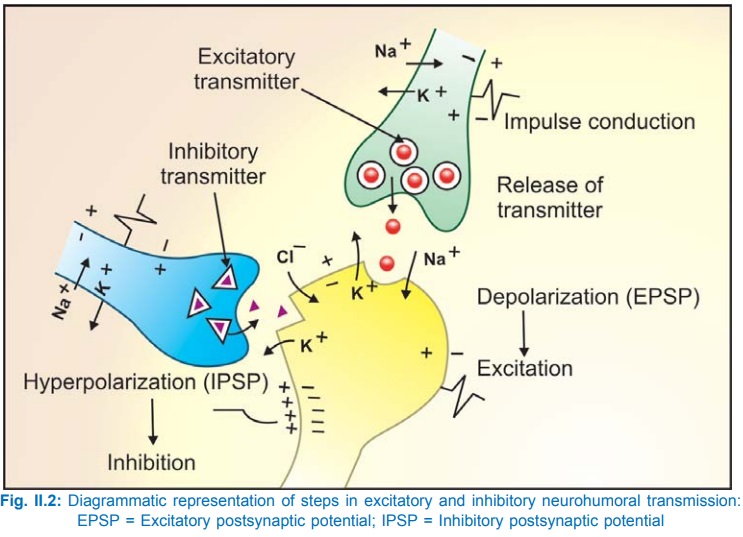Steps in Neurohumoral Transmission
| Home | | Pharmacology |Chapter: Essential pharmacology : Autonomic Nervous System: General Considerations
The resting transmembrane potential (70 mV negative inside) is established by high K+ permeability of axonal membrane and high axoplasmic concentration of this ion coupled with low Na+ permeability and its active extrusion from the neurone.
STEPS IN NEUROHUMORAL TRANSMISSION
Impulse Conduction
The
resting transmembrane potential (70 mV negative inside) is established by high
K+ permeability of axonal membrane and high axoplasmic concentration of this
ion coupled with low Na+ permeability and its active extrusion from the
neurone. Stimulation or arrival of an electrical impulse causes a sudden increase
in Na+ conductance → depolarization and overshoot (reverse polarization: inside
becoming 20 mV positive); K+ ions then move out in the direction of their
concentration gradient and repolarization occurs. Ionic distribution is
normalized during the refractory period by the activation of Na+ K+ pump. The
action potential (AP) thus generated sets up local circuit currents which
activate ionic channels at the next excitable part of the membrane (next node
of Ranvier in myelinated fibre) and the AP is propagated without decrement.
Tetrodotoxin
(from puffer fish) and saxitoxin (from certain shellfish) selectively abolish
increase in Na+ conductance in nerve fibres and thus block impulse conduction.
Transmitter Release
The transmitter (excitatory
or inhibitory) is stored in prejunctional nerve endings within ‘synaptic
vesicles’ (Fig. II.2). Nerve impulse promotes fusion of vesicular and axonal
membranes through Ca2+ entry which fluidizes membranes. All contents of the
vesicle (transmitter, enzymes and other proteins) are extruded (exocytosis) in
the junctional cleft.

A
number of proteins like synaptotagmin, synaptobrevin, neurexin, syntaxin and
synaptophysin located on the vesicular and axonal membranes have been found to
participate in the docking and fusion of the synaptic vesicles with the axonal
membrane resulting in exocytosis. These proteins can be targets of drug action
to modify junctional transmission.
The release process
can be modulated by the transmitter itself and by other agents through
activation of specific receptors located on the prejunctional membrane, e.g.
noradrenaline (NA) release is inhibited by NA (α2 receptor), dopamine,
adenosine, prostaglandins and enkephalins while isoprenaline (β2 receptor) and
angiotensin (AT1 receptor) increase NA release. Similarly, α2 and muscarinic
agonists inhibit acetylcholine (ACh) release at autonomic neuroeffector sites
(but not in ganglia and skeletal muscles).
Transmitter Action On Postjunctional Membrane
The released transmitter combines with specific receptors on the postjunctional
membrane and depending on its nature induces an excitatory postsynaptic
potential (EPSP) or an inhibitory postsynaptic potential (IPSP).
EPSP Increase in permeability to all cations → Na+ or Ca2+ influx
(through fast or slow channels) causes depolarization
followed by K+ efflux. These ionic movements are passive as the flow is down
the concentration gradients.
IPSP Increase in permeability to smaller ions, i.e. K+ and Cl¯ (hydrated K+ ion is smaller
than hydrated Na+ ion) only, so that K+ moves out and Cl¯ moves in (in the
direction of their concentration gradients) resulting in hyperpolarization.
In addition, a trophic
influence on junctional morphology and functional status is exerted by the
background basal release of the transmitter.
Postjunctional Activity
A suprathreshold EPSP generates a propagated postjunctional AP
which results in nerve impulse (in neurone), contraction (in muscle) or secretion
(in gland). An IPSP stabilizes the postjunctional membrane and resists
depolarizing stimuli.
Termination Of Transmitter Action
Following its combination with the receptor, the transmitter is
either locally degraded (e.g. ACh) or is taken back into the prejunctional
neurone by active uptake or diffuses away (e.g. NA, GABA). Specific carrier
proteins like norepinephrine transporter (NET), dopamine transporter (DAT),
serotonin transporter (SERT) are expressed on the axonal membrane for this
purpose. The rate of termination of transmitter action governs the rate at
which responses can be transmitted across a junction (1 to 1000/sec).
